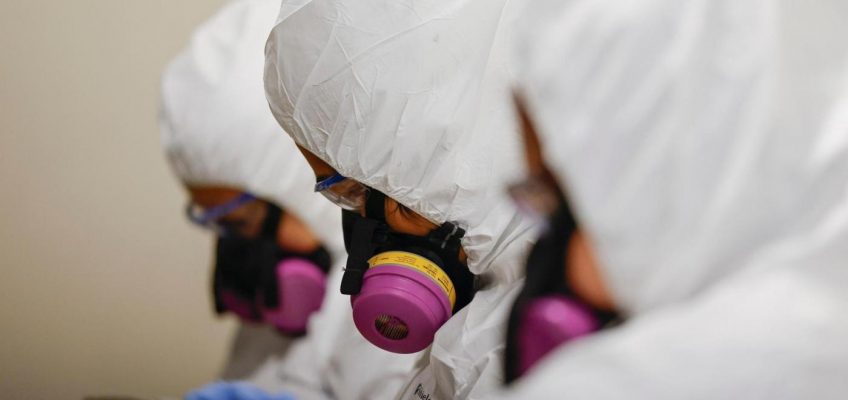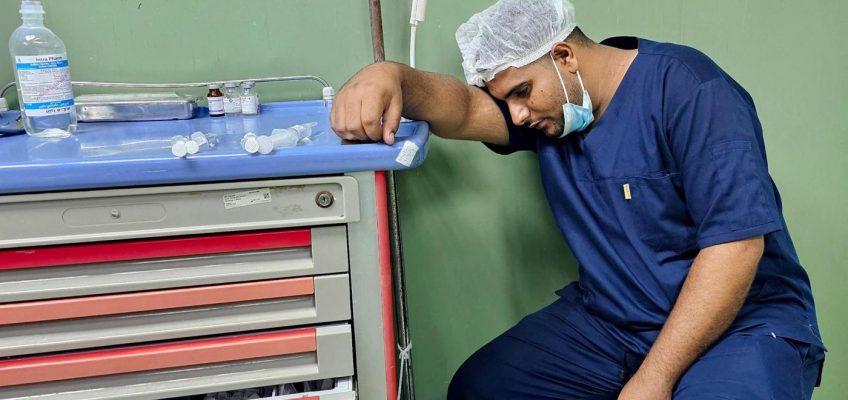By Colleen Shalby, Los Angeles Times
LOS ANGELES — Ash still clings to the windowsills of the gray home in Altadena, nine months after an inferno ripped the community apart.
Related Articles
Some Indigenous Peoples Day events strike conciliatory tone amid Trump’s focus on Columbus
‘This shutdown feels different.’ Some worry states might not get repaid when government reopens
Education Department layoffs hit offices that oversee special education and civil rights enforcement
China’s exports to US drop in September, while rise in global shipments hits a 6-month high
China shows no sign of backing down while issuing call for US to withdraw tariff threat
The couple who rents the house has moved 15 times with their newborn since January as their place of solace for the last decade has awaited testing and remediation to clear it of toxic material and debris.
Help has finally arrived. Wearing white hazmat suits that cover them from head to toe, gloves, respirator masks and goggles, a group of workers enters the residence.
When the U.S. Army Corps of Engineers completed its debris removal in Altadena after January’s fire tore through the town, the task to clean what survived didn’t stop. Hundreds of smoke-damaged and ash-filled homes remained standing on streets where others burned.
These efforts to clean them have largely been carried out by immigrant workers who have not just risked their health while clearing homes of toxic material and debris but, with ongoing raids, the lives they have built in California.
They meticulously vacuum, and scrub the walls, windows, baseboards and floors, clearing every open surface and precious possession of reminders of the Eaton fire.
Ricardo Melo has overseen more than 100 cleanups in Altadena and 25 in Pacific Palisades. He works for the National Day Laborer Organizing Network and said those he supervises have emigrated from Mexico, Central America and South America. Despite fears of deportation, his teams have continued to show up.
Ricardo Melo, a disaster site worker who is overseeing more than 100 cleanups in Altadena, stands in the back yard of Brent Morgan and Corine Harmon’s home on Friday, Oct. 3, 2025, in Altadena, California. (Carlin Stiehl/Los Angeles Times/TNS)
Melo’s approach to the cleanup is two-pronged: The first is ensuring that the workers understand who lived here before the fire — in this case a family with a baby — so that they will work diligently and with compassion. There’s no music on during the process — he wants the teams to concentrate.
The second is to make sure that his teams follow protocols to protect their own lives. A report from NDLON earlier this year found that many workers under contract with the Army Corps were not abiding by safety standards. Melo said he takes measures to prevent workers from absorbing or inhaling toxic chemicals.
“Every day, I remove all the bags and the filters from equipment because I don’t want to take contamination from one house to another house. I check every part of my equipment so that it’s good for the families and for the workers too,” Melo said. “Who’s going to clean up what’s inside their bodies?”
Two women, who spoke on the condition of anonymity for fear of being targeted by immigration enforcement, started doing remediation work after the fires burned homes in Altadena they had previously cleaned as housekeepers. They said that they feel safer working inside homes, where they’re shielded, than they do when they’re exposed outside or in transit.
The 34- and 49-year-old women have cleared dozens of homes in Altadena from debris and ash left by the Eaton fire. Although the work they are doing presents certain risks due to exposure to unknown toxic materials, they said that the threat of encounters with ICE causes greater panic.
Workers clean up contaminated possessions and surfaces months after the Eaton Fire at Brent Morgan and Corine Harmon’s home on Friday, Oct. 3, 2025, in Altadena, California. (Carlin Stiehl/Los Angeles Times/TNS)
“The exposure to the contaminants from the fire is some kind of fear, but it is double the fear that I feel when I think about ICE and what they’re doing with the raids,” one of the women said in Spanish, speaking through an interpreter. “There’s a way to protect us from the contaminants … but with the raids, we have seen that there’s not much that we can actually do.”
One of the women left Colombia for the U.S. with her husband and children to escape violence. The other left Honduras, one of the most violent countries in the world, in search of a better future. But the reality since the fires in January and then as the raids began this summer, she said, has been bleak.
“I don’t know that I believe [the future will get better] anymore. It’s been very hard, and the situation is actually getting worse. Nothing has been getting better for us,” she said, also speaking through an interpreter.
Outside the home in Altadena, trash bags are filled up with loose papers, textiles and anything from inside the house believed to be unsafe; mattresses, boxes of unused diapers and a new nursing chair that will be discarded line the driveway; a Christmas tree out front serves as a time capsule for what happened here.
Across the street, the burn scar on the mountains is visible.
The workers quietly and carefully tackle each room of the house while the garage has been turned into another cleaning zone where they box salvaged items.
Resident Brent Morgan, 42, is grateful for the help after months of seeking assistance after learning that his rental insurance had expired. Since then, he tried to find help that wouldn’t be too costly.
A worker cleans up contaminated possessions and surfaces months after the Eaton Fire at Brent Morgan and Corine Harmon’s home on Friday, Oct. 3, 2025, in Altadena, California. (Carlin Stiehl/Los Angeles Times/TNS)
The cleanup process is daunting. His wife, a professional dancer, has multiple costumes that have yet to be cleaned; it’s been so long since he’s been home that he doesn’t remember which photographs still cling to his fridge. The last several months have in many ways been a blur, but it’s unclear when normalcy will resume.
“It’s definitely been the most challenging time of our life, that’s for sure. Having a new baby was hard without all of this on top of it,” Morgan said. “We’re happy to hopefully move forward. It’s just the fact that with the baby being so young, we still just don’t know if it’s safe to be back. So all we can do is make progress and then do testing after and see if it’s clear.”
At a nearby church, all-day training sessions are held to teach workers how to prepare for risks on these job sites. Debora Gonzalez, the health and safety director at NDLON, carries out thought exercises with a group of workers, asking them to think through what obstacles they may face — such as fallen branches or gas — and how to assess the safety of an area. They learn to properly put on the protective gear required to go inside these homes in the coming days, helping each other step into their hazmat suits and affixing their masks over their noses and mouths.
Gonzalez has trained hundreds of workers on remediation efforts since January’s fires. She has worked with NDLON since 2019 and has helped to restore several communities in the aftermath of tragedy.
The fire that destroyed much of Altadena, she said, is one of the worst disasters she has seen.
“Raids are another disaster for us. And when a disaster happens, you can see what it does.”
©2025 Los Angeles Times. Visit at latimes.com. Distributed by Tribune Content Agency, LLC.




